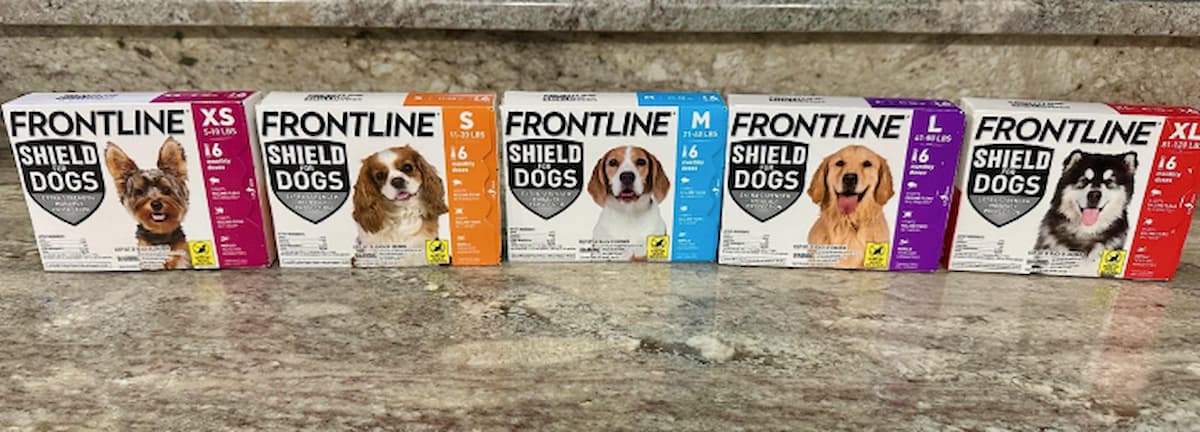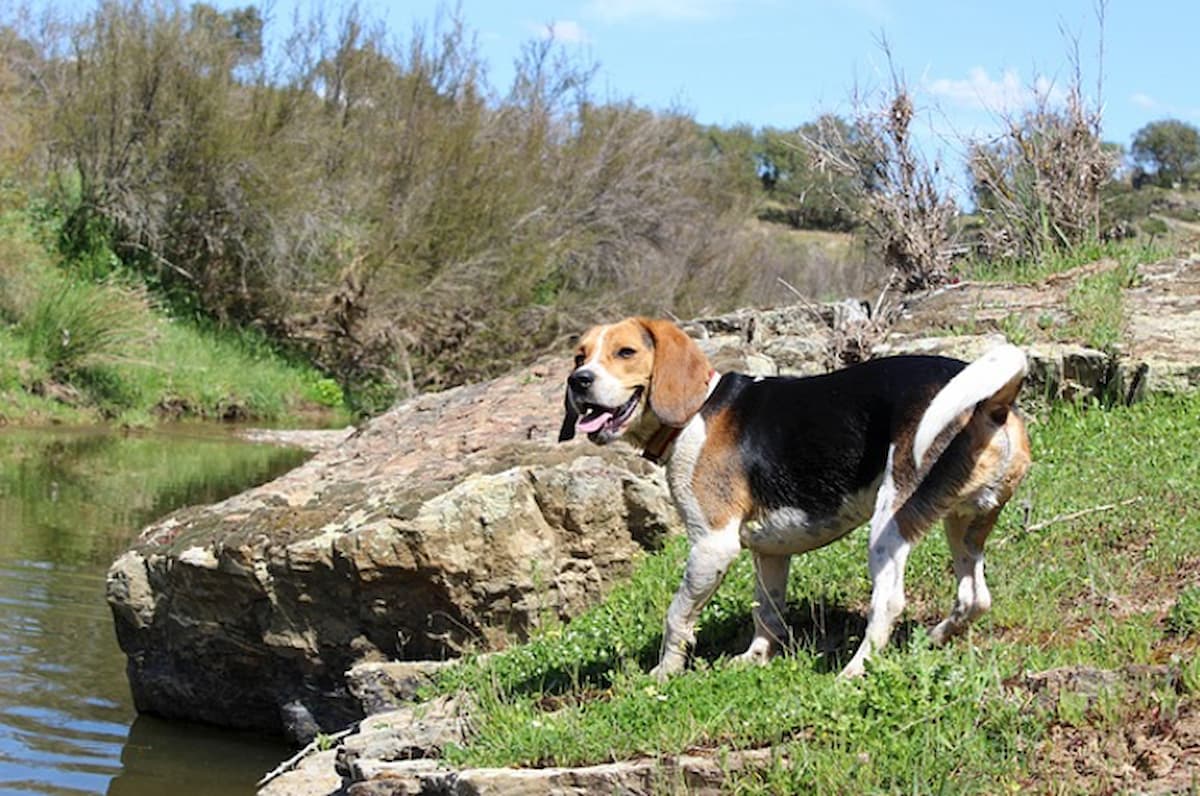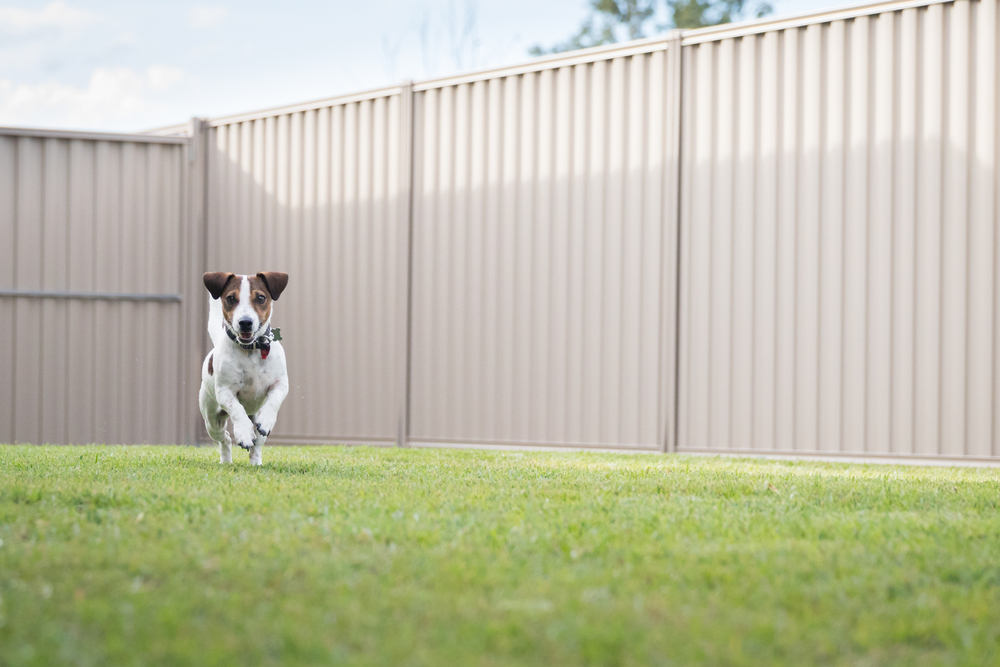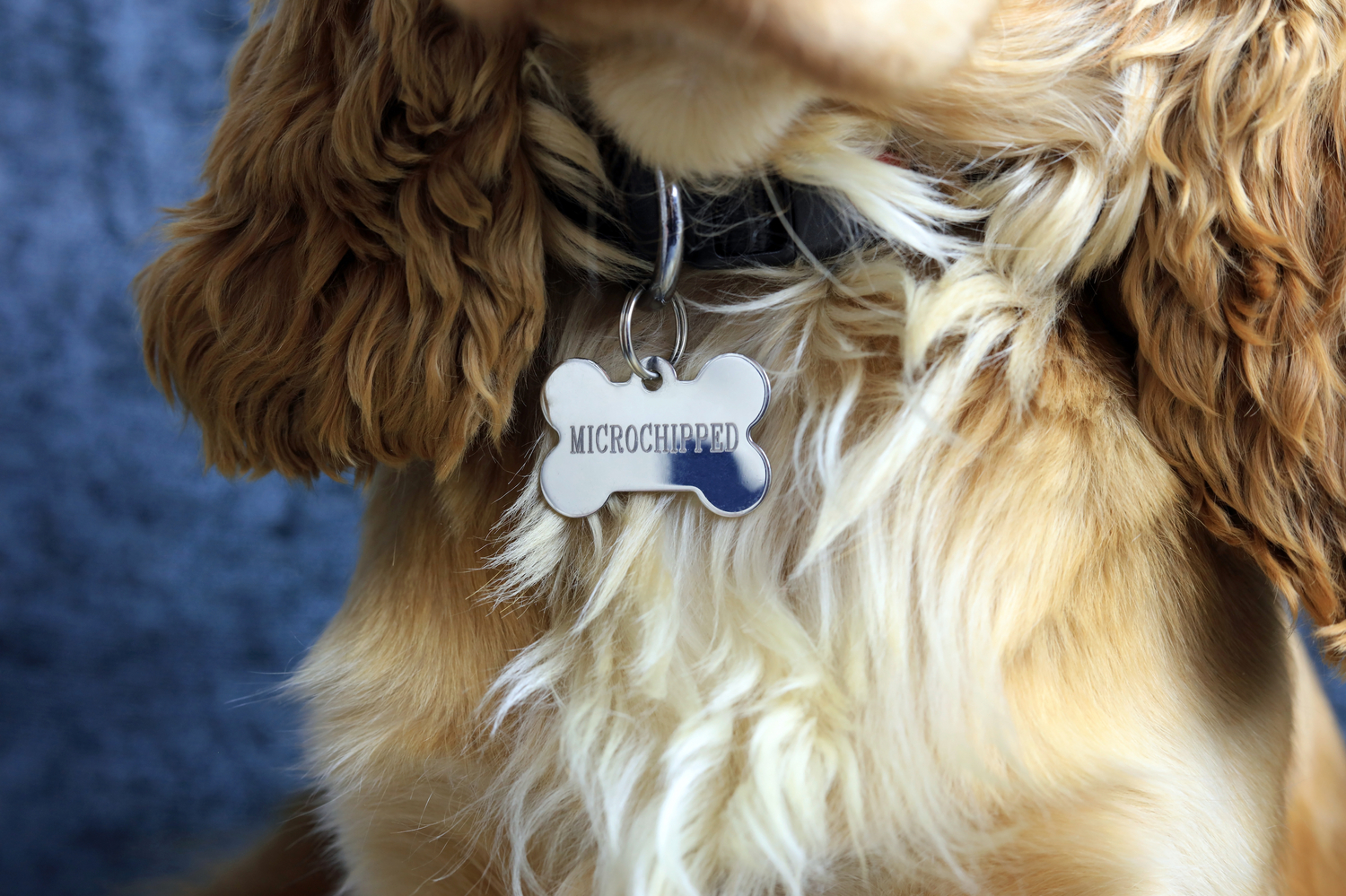6 Best Pet Safe Ice Melts to Use This Winter
Updated on February 20, 2024

When the winter forecast calls for snow and ice, many people break out the salt and shovels. Ice melt is an important tool for keeping sidewalks and driveways clear to help prevent slips and falls. But while ice melt is great for loosening ice and making it easier to shovel, certain types are not so great for our four-legged friends.
While we can’t forgo ice melts completely, there are alternatives to traditional rock salt that are safer for pets. We take a closer look at common ingredients in ice melts, what to look for on the label, and our picks for some of the best pet safe ice melts out there.
Pet Safe Ice Melts: Our Top Picks
All featured products are chosen at the discretion of the Vetstreet editorial team and do not reflect a direct endorsement by the author. However, Vetstreet may make a small affiliate commission if you click through and make a purchase.
- Best Overall Pet Safe Ice Melt: Safe Paw Ice Melter for Dogs
- Best Easy-to-Use Pet Safe Ice Melt: Morton® Safe-T-Pet® Ice Melt
- Best Pet Safe Ice Melt for Colder Climates: Diamond Crystal SNO-Paws Snow and Ice Melter
- Best Budget Pet Safe Ice Melt: Safe Step Sure Paws Ice Melt
- Best Pet Safe Ice Melt for Below Zero Temperatures: HARRIS Safe Melt Pet Friendly Ice and Snow Melter
- Best Pet Safe Ice Melt for Rotary Spreaders: Green Gobbler Pet Safe Ice Melt
6 Best Pet Safe Ice Melts
Best Overall Pet Safe Ice Melt
Our pick: Safe Paw Ice Melter for Dogs
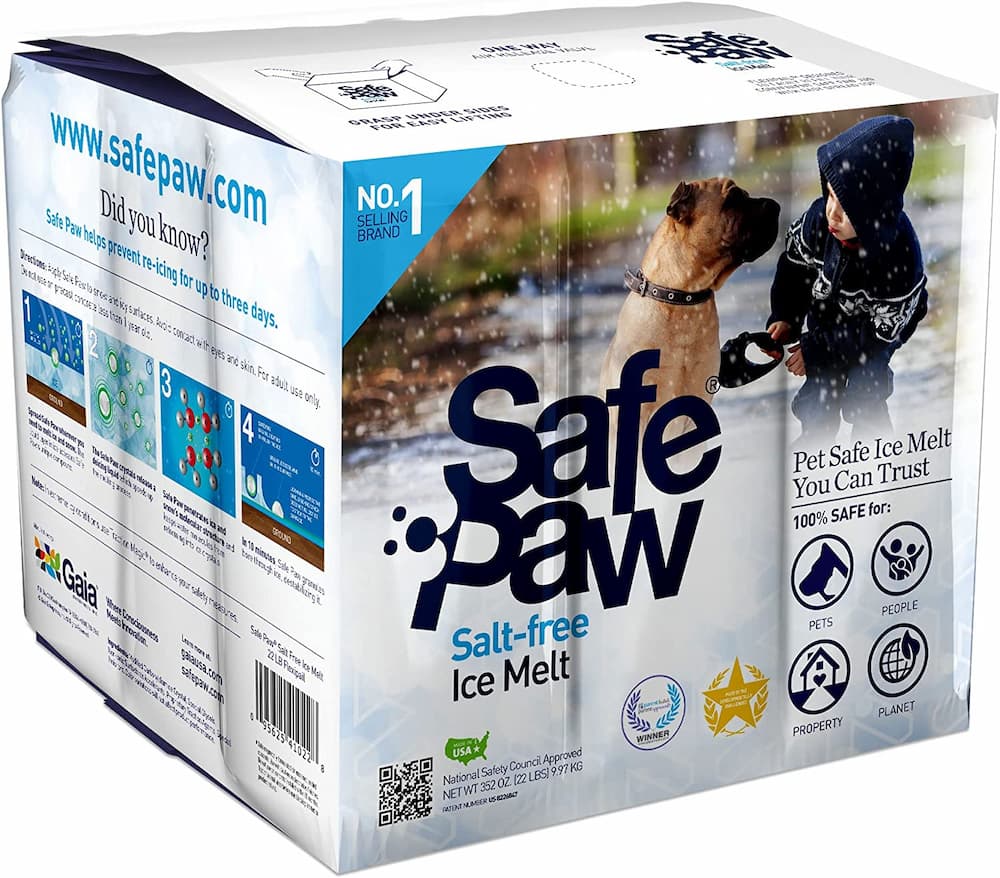
While choosing an ice melt that is safe for pets is your primary goal, it’s even better if it’s safe for people, the environment, and anything it touches, too. This long-standing product from Safe Paw is salt and chloride free. Using a patented system, it starts working right away to melt ice, and can keep an area ice free for around three days. It won’t burn your pet’s paws, and there’s no need to worry if your pet accidentally licks it (although if they consume a large amount or start showing symptoms of illness, you should still call your vet). According to Safe Paw, it’s made with modified carbonyl diamide crystals (urea) and special glycols.
It’s available in a smaller, easier to use 8-pound jug, but the larger 22-pound size is more economical. The price is around average for the amount of ice melt, and in return you have peace of mind that your pet will stay safe. Plus, with this formula, you can use half the amount of ice melt that you’d typically use and still see the same results.
Highlights
- Safe for people, pets, and the environment
- Safe to use on various surfaces, such as concrete, asphalt, pavers, and lawns
- Used and recommended by veterinarians
- Large bag is economically priced
- Unlimited shelf life
- 100 percent effective at 10 degrees Fahrenheit
Things to Consider
- Only the smaller size comes in a shaker jug. The 22-pound bag packaging may make it more difficult to spread evenly
- Works up to -2 degrees Fahrenheit
Best Easy-to-Use Pet Safe Ice Melt
Our pick: Morton Safe-T-Pet Ice Melt
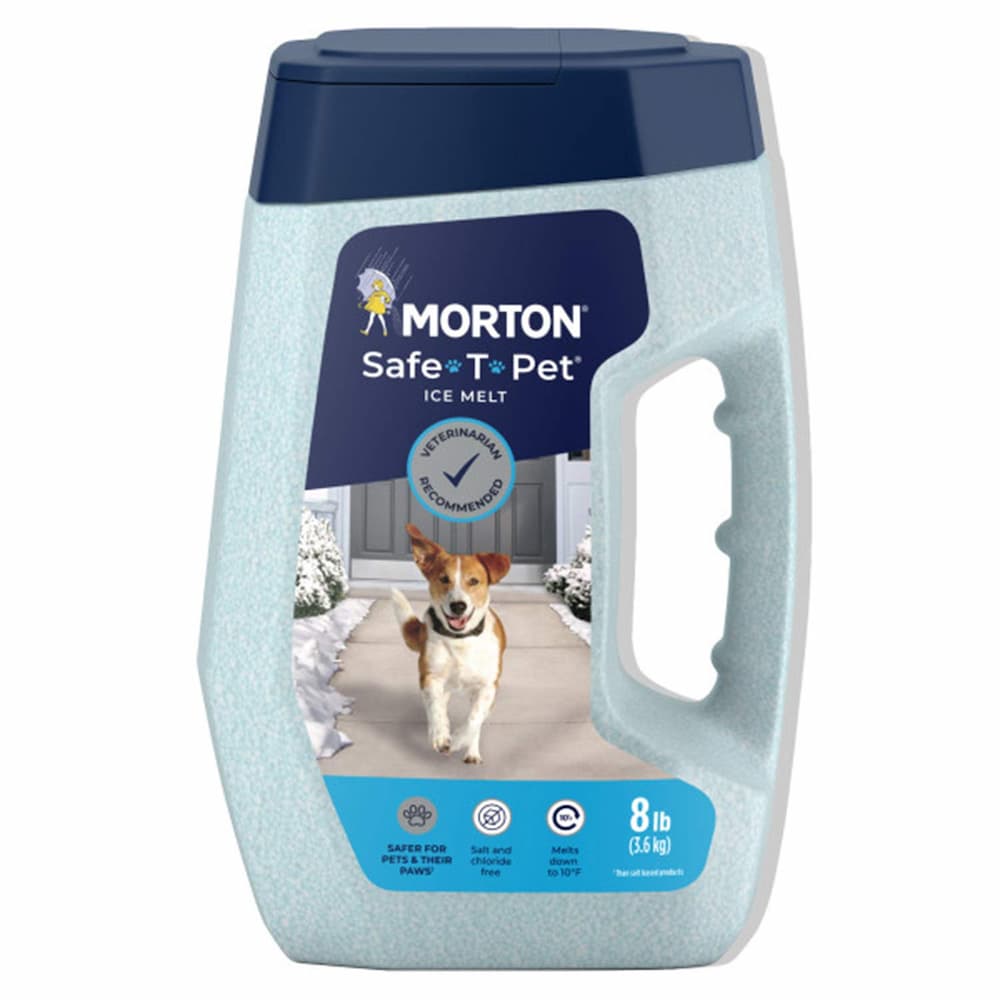
Ice melt containers can be big and bulky, which can seem very unnecessary and cumbersome if you just have a small area to treat. For those instances, try a pet safe ice melt like this one, which comes in a small 8-pound jug with a handle and easy-to-pour top.
The Morton ice melt is both salt and chloride free. Instead, it uses urea to melt ice. This is safe for paws and safe if your pet accidentally ingests it (within reason—a large amount could still cause issues, and in these cases be sure to call your veterinarian). It is generally considered safe for concrete and vegetation, too. However, urea is known to be damaging to plants when over-applied. It will melt ice in temperatures as low as 10 degrees Fahrenheit, so it might not be the best option for colder climates.
Highlights
- Lightweight with easy-pour spout
- Safer for pets than many other ice melts
- Works in temperatures as low as 10 degrees Fahrenheit
Things to Consider
- 8-pound jug only covers 340 square feet
- Urea-based ice melt should be avoided around cats
Best Pet Safe Ice Melt for Colder Temperatures
Our pick: Diamond Crystal SNO-Paws Snow and Ice Melter
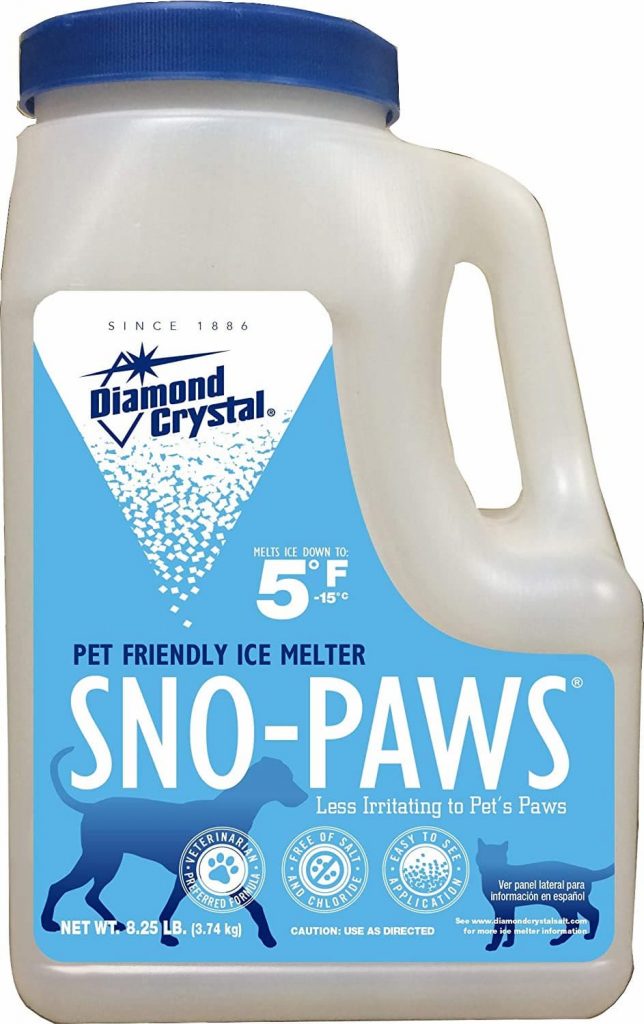
Like our previous pick, this ice melt contains urea and is available in an 8-pound jug for easy application, but it works at slightly colder temperatures, as low as 5 degrees Fahrenheit. Instead of relying on salts or chlorides, it features a combination of urea and specialized “performance boosting chips” that decrease the temperature at which it can melt ice.
Again, urea is one of the safest ice melt ingredients for dogs, since it won’t irritate pets paws and it is not as harmful if your pet accidentally ingests it. This ice melt also has a green tint, so it’s easy to see where it’s already been applied.
Highlights
- Urea-based ice melt with “boosters” melts at lower temperatures
- Ingredients are safe for dogs
- Green tinted granules to see where it’s already been applied
Things to Consider
- If you live in a climate where temps are sub-zero, you’ll need a stronger ice melt
- Urea-based ice melt should be avoided around cats
Best Budget Pet Safe Ice Melt
Our pick: Safe Step Sure Paws Ice Melt
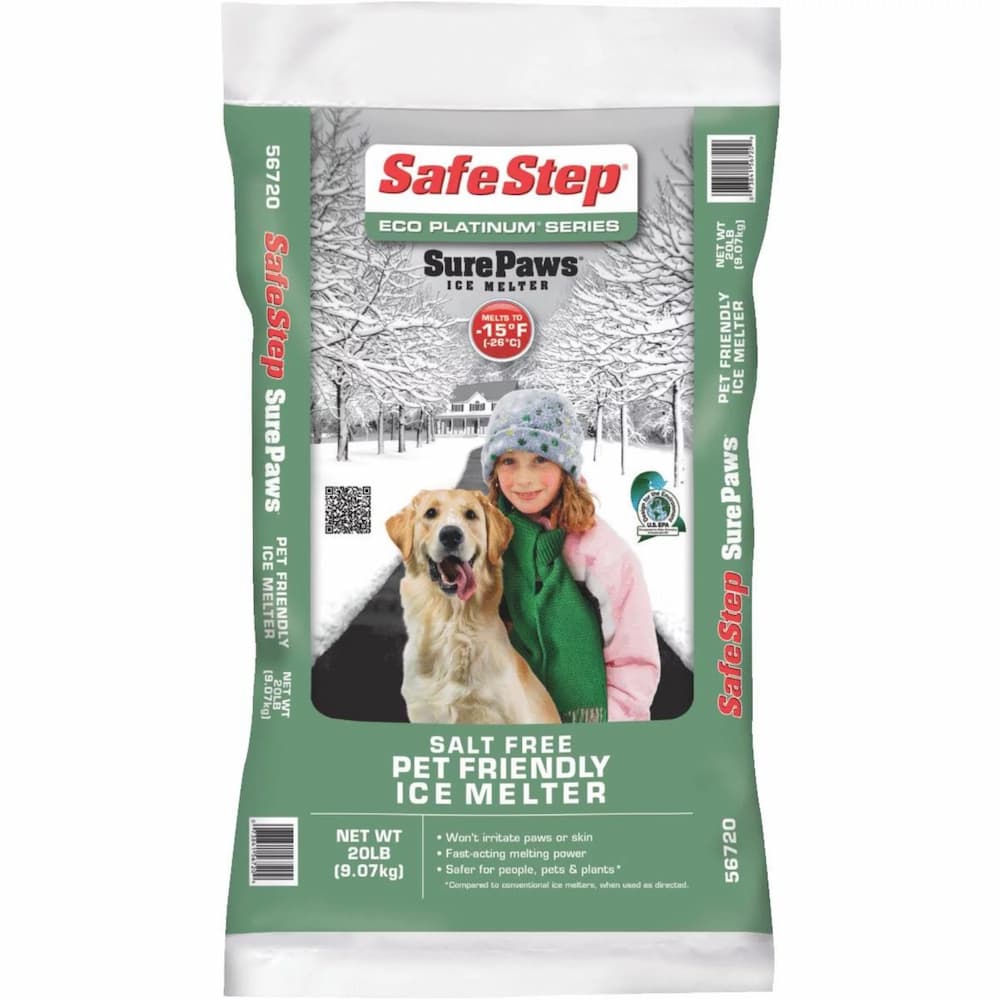
A 20-pound bag of pet safe ice melt for $20 makes this one of the most budget friendly options available. It’s made with magnesium chloride, and while it’s a safer alternative to rock salt, it isn’t entirely without safety concerns. It may be less likely to cause paw irritation, but it can still cause problems when ingested.
With that said, this ice melt is both affordable and a better choice than cheaper ice melts made with unsafe sodium chloride. It’s also a very effective ice melter: it works fast at extreme temperatures as low as -15 degrees Fahrenheit. It’s also less likely to damage grass and plants, and has even earned the designation of a “Safer Choice” by the EPA.
Highlights
- A safer alternative to traditional ice melts
- Works at temperatures as low as -15 degrees Fahrenheit
- Designated as a “Safer Choice” by the EPA
Things to Consider
- Magnesium chloride can still cause gastrointestinal issues if ingested
Best Pet Safe Ice Melt for Below Zero Temperatures
Our pick: HARRIS Safe Melt Pet Friendly Ice and Snow Melter
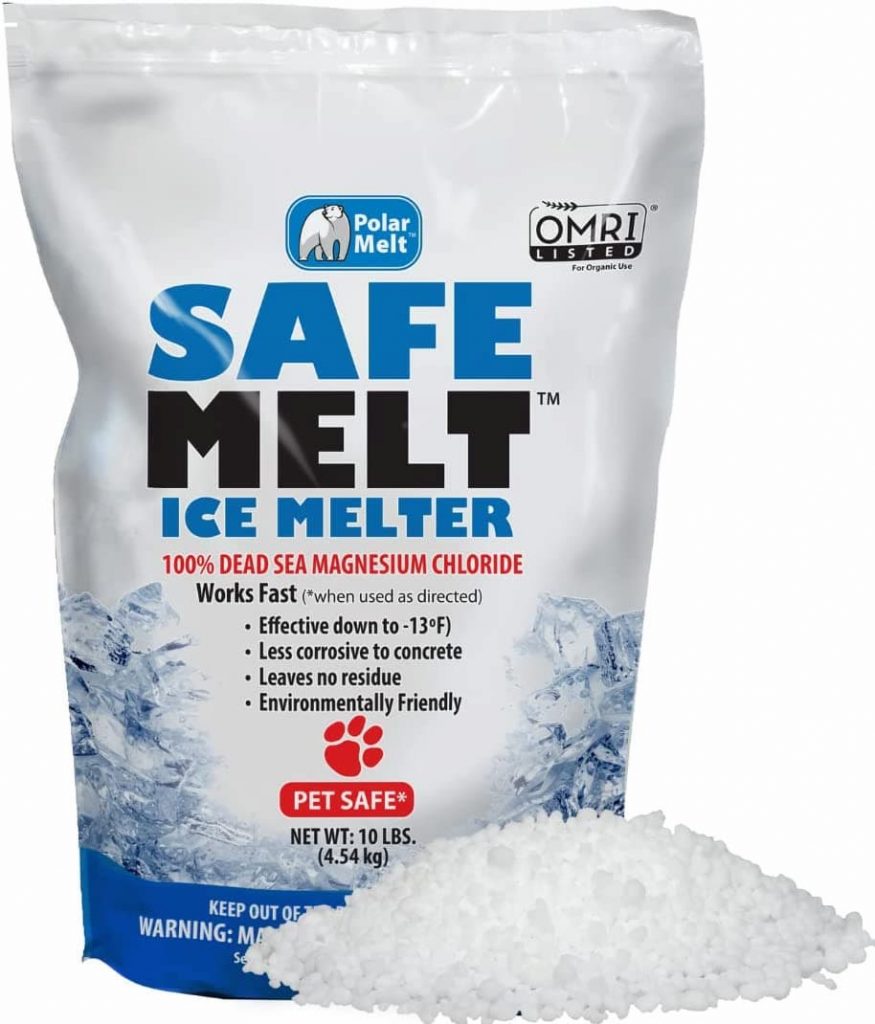
Ice melt decreases in efficacy as temperatures get colder, and while some won’t clear icy sidewalks when it falls below zero degrees—especially gentler pet-safe formulas—magnesium chloride typically gets the job done. This one starts working immediately, is effective down to -13 degrees Fahrenheit, and won’t corrode concrete like other ice melts can.
If pets step on the salt before it starts melting, like when pretreating sidewalks, the rounded pellets won’t hurt their paws like jagged, rough rock salt can. It’s also a little more affordable than other ice melts, at just over $20 for a 10-pound bag. It can be bulky to use, but a rotary spreader or decanting the ice melt into a smaller container will make it easier.
Highlights
- Melts ice in temperatures as low as -13 degrees Fahrenheit
- Won’t damage concrete or plants
- Rounded shape is less damaging to paws
Things to Consider
- Magnesium chloride can still cause gastrointestinal distress in dogs
Best Pet Safe Ice Melt for Rotary Spreaders
Our pick: Green Gobbler Pet Safe Ice Melt
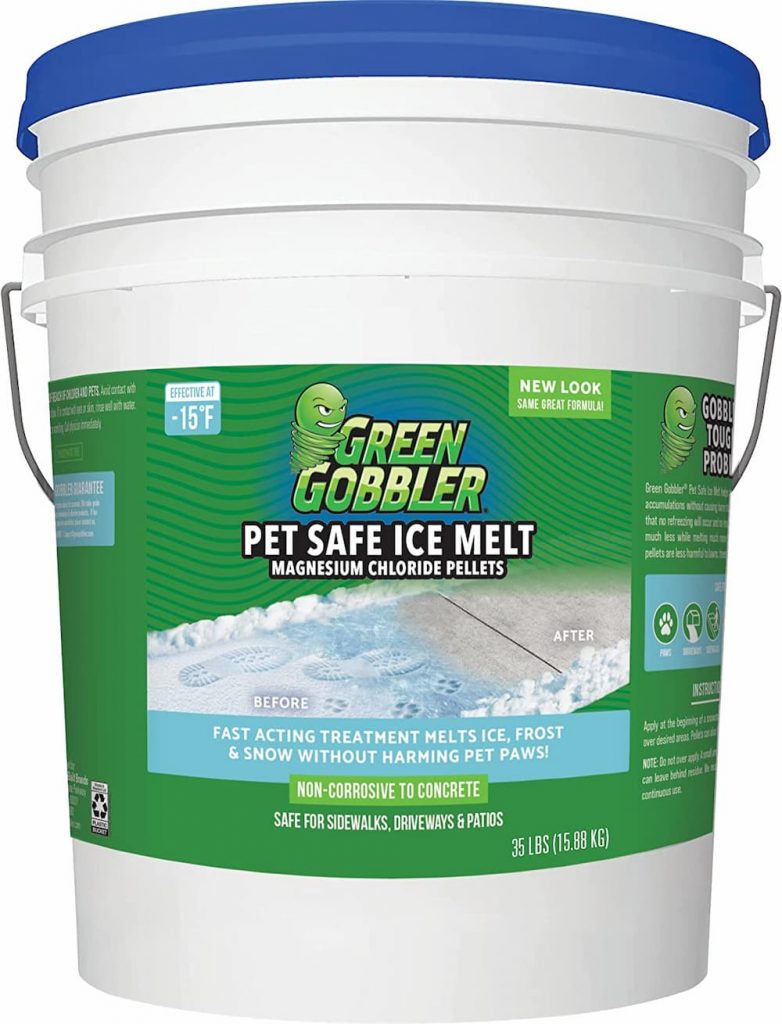
If you have a large area to apply ice melt, using a rotary spreader can make the process quicker and ensure a more thorough and even application. This ice melt uses magnesium chloride harvested from the Dead Sea, which allows for an effective ice melt while being safer for pets than rock salt.
This ice melt will start working right away, without corroding concrete or harming plants. It won’t irritate your dog’s paws either, but you should still wipe their paws off after a walk and make sure they don’t ingest it, as it could upset their stomach. For the best deal, purchase the large 35-pound pail, which costs less per pound than the smaller sizes.
Highlights
- Melts ice in temperatures as low as -15 degrees Fahrenheit
- Pellet size is ideal for use with rotary spreaders
- Won’t damage concrete or plants
Things to Consider
- Consuming too much of this ice melt may cause gastrointestinal issues
What Is a Pet Safe Ice Melt?
Ice melts or de-icers are substances that melt ice or stop it from forming. While no ice melt is 100 percent pet safe, some options are safer for pets than others.
Sodium chloride, or conventional rock salt, is one of the most commonly used types of ice melt. It’s also one of the worst options to use around pets. Not only are those jagged rocks painful for your dog to walk on, they also can burn the skin. And if your dog licks the sidewalk or his paws when you get home, it can cause gastrointestinal distress and other health issues, depending on how much is ingested. Salt poisoning from accidental ingestion of ice melt can cause lethargy, nausea, diarrhea, extreme thirst, increased urination, heart arrhythmias, and neurological problems, especially in small dogs.
Other common salts used in ice melts include magnesium chloride, potassium chloride, and calcium chloride. All three can cause gastrointestinal irritation in pets, but magnesium chloride is the safer option if you choose a salt-based ice melt.
There are also glycol-based ice melts available on the market: ethylene and propylene. While ice melt containing ethylene glycol does not harm pets’ paws the way rock salt does, it can be potentially deadly if ingested. (This is actually the same ingredient used in antifreeze.) What’s more, many pets will actually enjoy the sweet taste, making it more likely to be consumed.
Propylene glycol ice melt, which often contains urea, is one of the safest options for dog parents to consider. It’s safe for pet paws and is not harmful if your dog accidentally ingests it. However, it can be detrimental to cats and also tends to be less effective at melting ice than the other options. Signs of propylene glycol toxicity in cats include weakness, tremors, increased thirst and urination. Propylene glycol can also damage a cat’s red blood cells.
Some ice melt brands have gone so far as to create their own ice melt systems that are safer for pets and people.
Pet Safe Ice Melts: Buyer’s Guide
When choosing pet safe ice melts, first remember that no ice melt is truly 100 percent safe for pets, but there are ingredients to look for that are less harmful than others.
Magnesium chloride is a popular pet safe ice melt because it’s not only highly effective and works at lower temperatures, but it won’t irritate your pet’s paws either. It can be problematic if your pet ingests it, however. In most cases, there is no need to worry if your pet accidentally licks a small amount, but keep an eye out for any potential symptoms if they ingest more. Urea is another safe ingredient for dogs. It does not melt ice as effectively at low temperatures, but if it rarely dips below 10 degrees Fahrenheit in your area, it’s the ideal choice for a pet safe ice melt for dogs. Keep in mind that urea can be dangerous for cats.
When choosing a pet safe ice melt, look for brands you trust and with clear expertise in both pet safety and ice melt formulation. In general, pet safe ice melts tend to be more expensive, but the cost is worth it. Spending a little more on ice melt that won’t harm your pet is still cheaper than a vet bill, and easier than putting your pet through health issues.
Pet Safe Ice Melt FAQ
Is ice melt bad for dogs?
In some cases ice melt can be dangerous to use around dogs, especially those that contain sodium chloride (traditional rock salt). But that doesn’t mean you should risk walking on slippery surfaces, which can cause injuries to both you and your pets—not to mention anyone else who might walk on the icy surface. Instead, choose a pet safe ice melt and watch your pet closely to be sure they don’t ingest it.
Does ice melt hurt dogs’ paws?
Some ice melt can hurt dogs’ paws, both due to chemical burns and the jagged, crystal shape. Rock salt in particular, which is commonly used by cities for roads and sidewalks, can cause chemical burns to a pet’s paws and skin. Typically, neither of these are issues with pet safe ice melts, but areas pre-treated with ice melt may still have granules that can poke and bother your dog’s paws.
What ice melt is safe for dogs?
There are two commonly used, generally safe ice melt ingredients: urea and magnesium chloride. While these are a better choice than ice melts made with ingredients like sodium chloride or ethylene glycol, neither are 100 percent safe. They won’t irritate your pet’s paws, but both can be a problem if ingested in large amounts. Between the two, urea is the safer choice. Even when using pet safe ice melts, you should still take precautions like wiping your pet’s paws after a walk and making sure they don’t ingest any.
What to do if a dog eats ice melt?
If your dog eats ice melt, keep a close eye on their behavior. If possible, check the type of ice melt they’ve ingested along with the ingredients. In many cases, a small amount of ice melt is not cause for concern, especially in larger dogs, and especially if the formulation is urea-based. Contact your veterinarian right away if your pet has eaten a large quantity of ice melt, especially those containing sodium chloride or ethylene glycol, or if your pet shows signs of ingestion, such as gastrointestinal distress (like vomiting and diarrhea) or tremors. In any situation where you are concerned, it’s a good idea to check in with your vet.
Does cat litter melt ice?
No, cat litter doesn’t melt ice. Instead, it provides traction so that ice isn’t as slippery. It’s not a perfect solution though. Not only is it messy, it can also leave dangerous, slippery surfaces where large amounts of ice build up.
Pet Safe Ice Melt: Winter Tips
When the weather turns cold and people start using ice melts, keep an eye on your pet to be sure they don’t ingest any, and look for signs that ice melt may be causing them skin or stomach problems.
First, keep an eye on your pet’s paws for any signs of irritation. They might look red or rashy, or you might notice your dog licking them more often and/or limping. If you know your dog might have ingested ice melt, keep an eye out for gastrointestinal distress. Signs may include nausea or diarrhea, and in rare cases sodium toxicity from ice melt can cause symptoms like unsteadiness, seizures, and weakness. Not every case of a dog ingesting ice melt calls for a trip to the vet, depending on the size of your dog and the type and amount of ice melt ingested. If you’re unsure, call your veterinarian for advice.
If you take your dog on walks around the neighborhood, you can’t be sure what kind of ice melt is being used by other people. In many cases, it won’t be pet-friendly. This is why it’s a good idea to wipe your dog’s paws off after every winter walk where they might step on ice melts.
If you often walk on city sidewalks, which typically use non-pet friendly rock salt, protect your dog’s paws with dog booties. This prevents chemical burns from ice melt, and also keeps their paws warm in cold temperatures.

